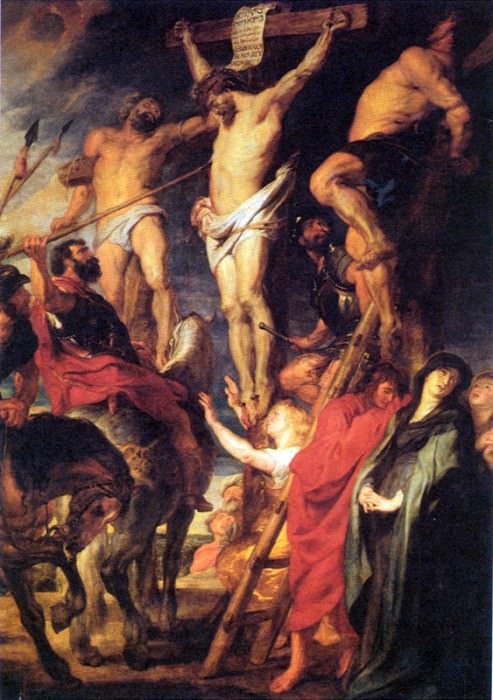Strike with a Lance * Peter Paul Rubens (1577-1640)
Peter Paul Rubens (After) – Strike with a Lance
Edit attribution
Download full size: 563×800 px (0,2 Mb)
Painter: Peter Paul Rubens
The Crucifixion of Jesus Christ is one of the most popular and favorite subjects of Renaissance and Baroque artists. Peter Paul Rubens resorts to this subject in 1606. What attracts the most attention in the work is the depiction of the body of Jesus Christ. He was crucified on a tall wooden cross. The man’s body is quite flabby and sagging under the weight. If his hands and feet had not been nailed down, he would have fallen long ago.
Description of Peter Rubens’ painting "Crucifixion
The Crucifixion of Jesus Christ is one of the most popular and favorite subjects of Renaissance and Baroque artists. Peter Paul Rubens resorts to this subject in 1606.
What attracts the most attention in the work is the depiction of the body of Jesus Christ. He was crucified on a tall wooden cross. The man’s body is quite flabby and sagging under the weight. If his hands and feet had not been nailed down, he would have fallen long ago. But he continues to hang, and his body is not allowed to be removed. There is a metal wreath with prongs on Jesus’ head and a snow-white bandage on his thighs. Above the martyr’s head is a small parchment. The man’s head hangs on his chest, with scarlet blood running down his arms.
In addition to Jesus, two other men were also crucified. But they are still alive and in terrible pain. Their bodies wriggle on the crosses, they try to escape, to escape, to remove the savage pain that pierces their whole body. But the Roman legionnaires carefully watch over them. The canvas depicts two riders on horseback. Another executor of the sentence has placed a ladder to one of the crosses and is trying to punish the obstinate crucified man. A total of twelve people are depicted in the work.
In the lower right corner we see several women who have come to mourn Jesus. Among them we can discern the figures of Our Lady and Mary Magdalene. Our Lady is depicted in a long dark blue dress, with a black shawl draped over her shoulders and head as a symbol of mourning. The mother can no longer bear to look at what has happened to her child. The woman is turned to the side, her head tilted to the side, her eyes looking upward. She looks as if she is about to faint or fall into agony. Below the cross is Mary Magdalene. She is trying to protect, to cover the body of Jesus Christ.
The sky is depicted dark, with large, looming clouds. The sun, which perpetually illuminates the firmament, is now almost invisible - an eclipse has occurred.
Кому понравилось
Пожалуйста, подождите
На эту операцию может потребоваться несколько секунд.
Информация появится в новом окне,
если открытие новых окон не запрещено в настройках вашего браузера.
You need to login
Для работы с коллекциями – пожалуйста, войдите в аккаунт (open in new window).










![Peter Paul Rubens - Equestrian portrait of King Philip IV of Spain [circle]](http://cdn.gallerix.asia/j/_EX/754398988/2948910682.webp)



![Peter Paul Rubens - The Feast of Herod [After]](http://cdn.gallerix.asia/j/_EX/754398988/8528.webp)





You cannot comment Why?
The central figure, positioned high above, displays a posture suggesting both suffering and resignation. His body is rendered with anatomical precision, emphasizing muscularity and vulnerability simultaneously. The light falls dramatically upon him, highlighting his form against the darker background and intensifying the sense of pathos.
Surrounding this central figure are numerous individuals engaged in various actions. Several men appear to be actively involved in raising or manipulating the structure, their bodies straining under the effort. One figure thrusts a long spear towards the suspended body, an action that introduces a note of aggression and violence into the scene. Others seem to observe with expressions ranging from grief to detached curiosity.
Below, a group of women and children are depicted in postures of lamentation and distress. Their faces are contorted in anguish, their gestures conveying profound sorrow. A woman in red stands out due to her vibrant color and outstretched arms, seemingly reaching towards the central figure in an act of desperate supplication. The presence of children amplifies the emotional impact, suggesting a loss that transcends individual suffering and affects the entire community.
The artist’s use of light and shadow is particularly noteworthy. Strong contrasts between illuminated areas and deep shadows create a dramatic effect, emphasizing the physicality of the figures and contributing to the overall sense of tension. The palette is dominated by earthy tones – browns, ochres, and reds – which reinforce the somber mood and evoke a feeling of antiquity.
Beyond the immediate narrative, the painting seems to explore themes of sacrifice, suffering, and human response to tragedy. The depiction of both perpetrators and witnesses suggests a complex interplay of guilt, responsibility, and empathy. The crowded composition and dynamic arrangement of figures convey not only physical pain but also the psychological weight of witnessing such an event. It is a scene charged with emotional intensity, prompting reflection on the nature of faith, loss, and human compassion.